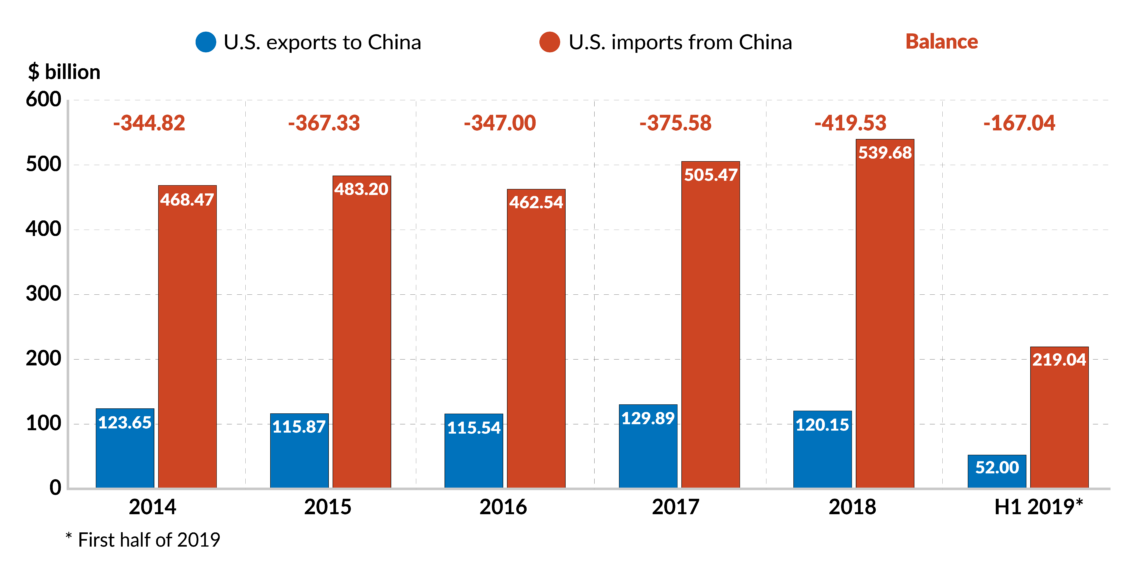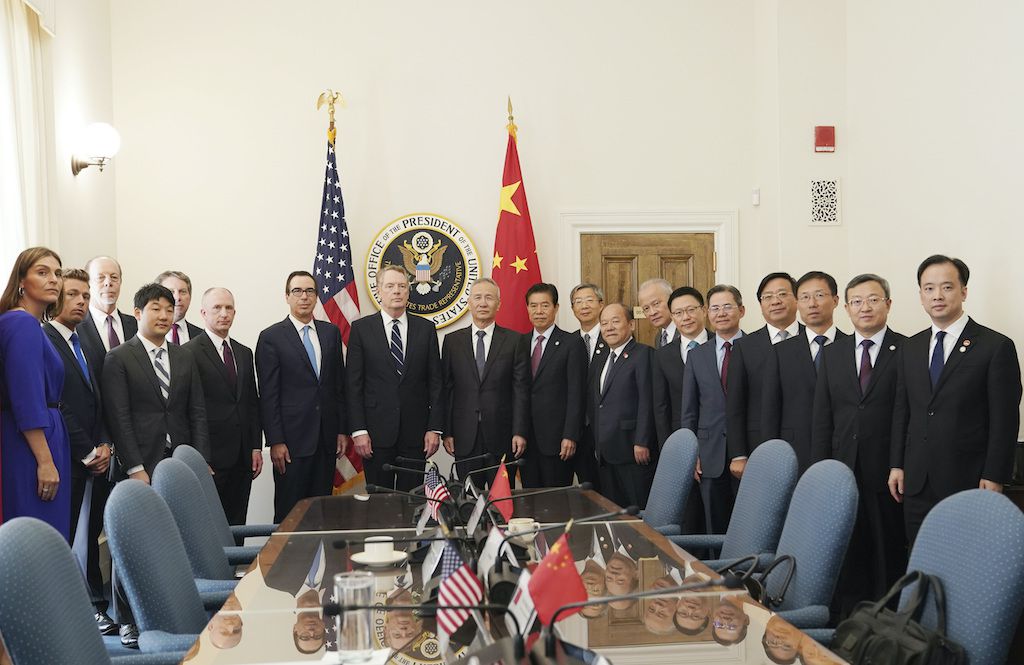The U.S.-China trade tug-of-war, status report
U.S. President Trump’s administration may find it possible to clinch the first phase of a comprehensive trade deal with China as a way to harvest the low-hanging fruit. The real challenge will be completing Phase Two, which will cover more contentious issues.

In a nutshell
- President Trump’s use of tariffs against China has a downside
- The tariffs could backfire politically if consumer prices rise
- A partial trade deal could ease transpacific relations
More than two years have passed since the administration of United States President Donald Trump began its investigation into China’s trade practices. To date, hundreds of billions worth of goods traded between the two countries have become more costly as a result of tariffs imposed on both sides of the Pacific.
President Trump had talked about getting a trade deal with China long before his administration started applying pressure for one. Today, the first part of a trade deal with China is completed and considered imminent. The problem will be getting a follow-up deal as the 2020 presidential election cycle kicks in. Another unknown is whether some, if any, of the duties levied recently will be removed or reduced.
Getting to Phase One
As of November 2019, the U.S. has levied tariffs from 15 percent to 25 percent on more than $360 billion worth of imports from China. From the Trump administration’s standpoint, the purpose of these tariffs has been twofold. President Trump enjoys collecting tariff revenue; he sees the measures as a bargaining and enforcement tool. The U.S. Customs and Border Protection has collected roughly $38 billion worth of taxes from American importers since the first tariffs were levied in July 2018.
On October 10 and 11, 2019, as a part of trade negotiations, President Trump hosted Vice Premier Liu He of the People’s Republic of China at the White House. Mr. Trump laid out the next steps of the process: an initial agreement (a Phase One deal) and potential follow-up agreements (Phase Two and Three deals).
The U.S. president has continued his tactic of threatening Beijing with higher tariffs if China proved unwilling to make a deal.
According to the president, the Phase One deal includes China’s obligation to purchase $40 to $50 billion worth of U.S. farm products per year, remove tariff and nontariff barriers to U.S. agricultural imports, purchase up to $20 billion worth of Boeing planes, open up financial services and markets to U.S. entities in China, improve China’s intellectual property protection, and stop the transfer of technology to Chinese entities. The package may include an agreement on U.S.-Chinese currency exchange. According to Mr. Trump, the Phase One deal would represent roughly 60 percent of the total trade pact – implying the remaining 40 percent would be covered in future phases of the accord. Negotiations for Phase Two would begin immediately upon the completion of Phase One.
During that announcement, possibly as a sign of good faith, President Trump also decided not to increase the current tariff rate on roughly $250 billion worth of imports from China from 25 percent to 30 percent, a measure that had been scheduled to take effect shortly. Since that declaration, however, the U.S. president has continued his usual tactic of threatening the Chinese with even higher tariffs if they proved unable, or unwilling, to make a deal.
Phase One was supposed to have been signed already. Presidents Trump and Xi Jinping of China were to meet on the sidelines of the Asia-Pacific Economic Cooperation (APEC) summit in Santiago around mid-November. Chile canceled the event due to domestic unrest, but the silver lining has been that the U.S. and China’s negotiators received more time to work on the deal. Phase One, considered the easiest (as it is supposed to pick the low-hanging fruit), had proven hard to finalize following the setback in the May 2019 negotiations.
The hurdles remain the same: Beijing wants Washington to remove or reduce more tariffs than the U.S. is willing to accept. Over the past year, the Chinese negotiators have made clear that they wanted all the tariffs gone but would also like the agricultural purchases of China to be based on market demand, not just what the U.S. negotiators wished the country to buy. The deal, Beijing insisted, needed to respect China’s national independence as well – meaning China does not want to change its laws.
The last thing the Trump administration would want is to harm U.S. consumers with higher taxes before an election year.
Of these demands, tariffs are the stickiest issue. It is not hard for China to agree to take in more farm products from the U.S. when its agricultural sector is in poor shape, as it is now. Some Chinese experts have also suggested that China may be willing to adjust some of its laws to U.S. demands, so long as the changes are not tied to the trade deal. Chinese officials do not want to be seen as caving in to external pressure. The elimination of tariffs, on the other hand, goes to the heart of Mr. Trump’s strategy. He wants to keep a minimum of them levied until China can fully implement its side of the grand trade agreement.

Now, all eyes are on the next U.S. tariff threat: the 15 percent surcharge that could be imposed on roughly $160 billion worth of imports from China starting on December 15, 2019. President Trump, according to sources, will postpone these tariffs whether there is a deal signed by December 15 or not. The measures were initially intended to take effect on September 1, but the president delayed them to avoid affecting U.S. holiday shopping around Thanksgiving and Christmas. The tariffs would apply to consumer goods like computers and video game consoles. The last thing the Trump administration would want is to harm the U.S. consumer base with higher taxes before going into an election year. Private consumption has been driving U.S. economic growth in the last few quarters.
Getting to Phase Two
The chances for a Phase One deal with China are high, but it is unclear whether this will happen this year or early in 2020. The longer it takes to secure the first stage, the more likely the next step of the process will be negatively impacted by the 2020 presidential election in the U.S. In this context, what are the possible scenarios for the future of the U.S.-China trade tug-of-war?
The United States-China trade conflict
| 2018 | |
| March 1 | U.S. President Donald Trump announces tariffs on imported steel and aluminum, also from China |
| March 22 | The administration reveals a plan to slam 25% tariffs on $50 billion worth of Chinese goods. China announces tariffs in response to the steel and aluminum duties and promises to respond to the latest U.S. duties |
| April 3 | The U.S. presents a list of Chinese goods subject to its tariffs; the industries affected are granted 60 days to apply for exemptions |
| April 4 | China subjects more than 100 U.S.-made products, worth some $50 billion, to retaliatory tariffs |
| May 21 | The two countries outline a trade deal to stop the trade conflict |
| May 29 | Following a snag in the negotiations, the White House announces its tariffs on $50 billion worth of Chinese products will go forward, with the final list of goods to be released on June 15 |
| June 15 | President Trump rolls out the list of goods. It imposes a 25% tariff on $34 billion worth of Chinese imports as of July 6, with another $16 billion worth of imports subject to the tariff at a later date. China responds with an equivalent package of tariffs |
| June 18 | The Trump administration threatens to impose a new 10% tariff on another $200 billion worth of imports from China |
| July 6 | U.S. tariffs on $34 billion worth of Chinese goods take effect; China retaliates in kind |
| July 10 | A list potentially subjecting an additional $200 billion worth of Chinese goods to 10% tariffs is published by the U.S. |
| August 1 | Washington more than doubles the value of tariff threats against China by outlining a plan to increase duties on $200 billion worth of Chinese goods from 10 % to 25% |
| August 3 | China expresses readiness to impose new tariffs on another $60 billion worth of U.S. goods if President Trump acts on his latest threat |
| August 7 | The U.S. announces that the second tranche of duties, to hit $16 billion worth of Chinese goods, will take effect on August 23 |
| August 23 | The U.S. tariffs go into effect and Beijing responds with duties on $16 billion worth of US goods |
| September 7 | President Trump confirms that the tranche of tariffs on $200 billion worth of Chinese goods will soon come into effect and raises the stakes by threatening to impose another $267 billion worth of duties on Chinese goods |
| September 17 | Chinese goods worth $200 billion are hit with tariffs U.S., with the 10% rate scheduled to increase to 25% on January 1, 2019 |
| December 1 | Presidents Trump and Xi meet during the G20 summit in Argentina to reach a truce, delaying the escalation of U.S. tariffs until March 1 |
| 2019 | |
| February 24 | After a series of negotiations, the U.S. indefinitely delays the tariffs increase planned on March 1 |
| May 5 | The U.S. accuses China of reneging on past trade commitments and threatens to raise tariff rates and slam duties on another $300 billion worth of Chinese goods |
| May 10 | President Trump makes good on the latest threats and increases import taxes to 25% on some $200 billion worth of goods from China. Washington gives Beijing a four-week deadline for a deal |
| May 13 | China retaliates, announcing its tariffs on $60 billion worth of U.S. goods will go up on June 1 |
| May 15 | President Trump bans U.S. companies from using telecommunications gear from “foreign adversaries” |
| May 21-22 | President Xi signals that China is readying itself for a prolonged standoff with the U.S. |
| June 2 | China releases a policy paper blaming the U.S. for stalled trade negotiations; the U.S. trade representative objects |
| June 10 | President Trump threatens that tariffs on $300 billion worth of Chinese products will take effect "immediately" if progress is not made at his anticipated meeting with President Xi in Japan at the end of the month |
| June 17 | Hundreds of company representatives travel to Washington to testify against planned tariff escalations before the U.S. trade representative. Most of them warn that taxing all imports from China would increase domestic costs and threaten U.S. jobs |
| June 29 | Presidents Trump and Xi reach a cease-fire deal on the sidelines of the G20 meeting in Osaka, Japan, delaying planned tariffs on roughly $300 billion worth of Chinese products. They agree to restart the negotiations that stalled in May |
| July 9 | Weeks after blacklisting Huawei, the U.S. Commerce Department agrees to consider issuing licenses to companies that do business with the Chinese telecommunications giant |
| July 11 | President Trump accuses China of reneging on a past commitment to purchase more U.S. farm products |
| July 29-31 | U.S. officials resume trade talks with Chinese officials in Shanghai. Both sides portray the discussions as constructive |
| August 1-2 | In an abrupt reversal, President Trump declares the U.S. will move forward with tariffs on virtually all remaining imports from China; Beijing warns it will retaliate |
| August 5 | The U.S. Treasury Department labels China as a currency manipulator and Beijing threatens to stop the purchases of American agricultural products |
| August 13 | In a rare acknowledgment that tariffs can raise prices in the U.S., the Trump administration postpones a set of tariffs on China, planned to take effect September 1, until December 15 to avoid disruptions to the holiday shopping season |
| August 23 | China announces retaliatory tariffs on $75 billion worth of U.S. products and says it will reinstate duties on cars. President Trump vows to hit back by raising the tariff rates on Chinese products by about 5%. The president also orders private U.S. companies to leave China, even though the command carries no legislative weight |
| September 1 | The Trump administration follows through with plans to enact tariffs on some $122 billion worth of Chinese imports, including clothing and household staples; China retaliates with tariffs on thousands of American products including cars |
| September 11 | China exempts 16 American types of merchandise from duties, including animal feed ingredients and cancer drugs |
| September 19 | Deputy-level trade officials from the two countries meet in Washington to lay the framework for higher-level negotiations |
| September 20 | The U.S. exempts about 400 Chinese products from tariffs, in a sign that the trade dispute is taking a toll on American companies; China cancels planned visits to American farms in the Midwest |
| October 7 | The U.S. adds 28 technology companies in China to an export blacklist; Chinese Foreign Ministry spokesman hints at future retaliation |
| October 10 | President Trump, U.S. Trade Representative Robert Lighthizer and Treasury Secretary Steven Mnuchin host the 13th round of economic talks in Washington with a delegation led by Chinese Vice Premier Liu He |
| October 11 | The U.S. announces a so-called Phase One trade agreement with China, said to involve intellectual property rules, financial market access and agricultural purchases. President Trump stops scheduled escalations that would have increased tariff rates on thousands of Chinese products up to 30% |
| October 29 | China says it will take steps to ease foreign investment restrictions and technology rules. Key terms of the interim trade agreement are still not on paper, remain elusive |
| November 15 | The two sides continue to negotiate. Multiple White House sources say the president is not ready to sign anything yet |
| November 25 | China rolls out plans to firm up its rules on patents, copyrights and trademarks |
| November 29 | The U.S. announces it will exempt dozens of products from tariffs. The move is seen as a way to mitigate domestic concerns ahead of the 2020 elections |
Scenarios
Scenario One, best case
Presidents Trump and Xi meet in Iowa to sign a Phase One deal before the new year. Tariffs on all but $50 billion worth of Chinese imports into the U.S. are removed. China agrees to open up more of its protected sectors to foreign investment and provide less state support in the areas the U.S. is most concerned about (such as investments toward the Made in China 2025 initiative). The U.S.-China diplomatic and economic relationships stabilize until the presidential elections.
Scenario Two, middle of the road
The two presidents meet before the end of the year. The threat of tariffs scheduled for December 15 is removed. But additional duties on $360 billion worth of imports remain as negotiators continue to go back and forth until the election. To mitigate any significant adverse effect on the U.S. economy from the prolonged trade conflict, the Office of the U.S. Trade Representative prioritizes giving more companies exemptions from the levies.
Scenario Three, worst case
Presidents Trump and Xi fail to meet before the election. Mr. Trump concludes that the negotiations have hit a wall and decides to move ahead with the December 15 tariffs. He also chooses to raise the ante, perhaps return to the threat of increasing the tariff rate on roughly $250 billion worth of imports from 25 percent to 30 percent. He also threatens to raise the tariff rate from 15 percent to 25 percent on approximately $300 billion worth of imports.
Each of these scenarios depends on whether President Trump sees negotiations as fruitful, whether he believes the talks will have an effect on his reelection and whether the current growth rate in the U.S. economy can be maintained until November 2020.
Presidential election effect
As the U.S. moves deeper into the presidential election cycle, a few things are certain. There will be more discussions between candidates on how the U.S.-China economic, strategic, and diplomatic relations should be managed. Congress could begin criticizing China’s industrial and trade policies more pointedly. New laws may even be drafted, aiming to reshape or restrict the U.S.-China relationship. However, most of the legislation introduced over the next year is unlikely to be passed before the end of the 116th Congress (end of 2020).
During the presidential debates and on election day, the China problem will still be secondary to more politically sensitive domestic issues – such as immigration, healthcare and the economy. While the U.S.-China trade dispute reaches into both the economic and strategic fields, it is still not a priority for most U.S. voters. For the U.S.-China situation to become a big campaign issue, it would need to start having a more significant effect on Americans’ wallets and employment. A Phase One agreement may be enough to keep consumers happy going into the election, but the prospects of a Phase Two deal are limited.








